1995 GMC SIERRA ESP
[x] Cancel search: ESPPage 28 of 488
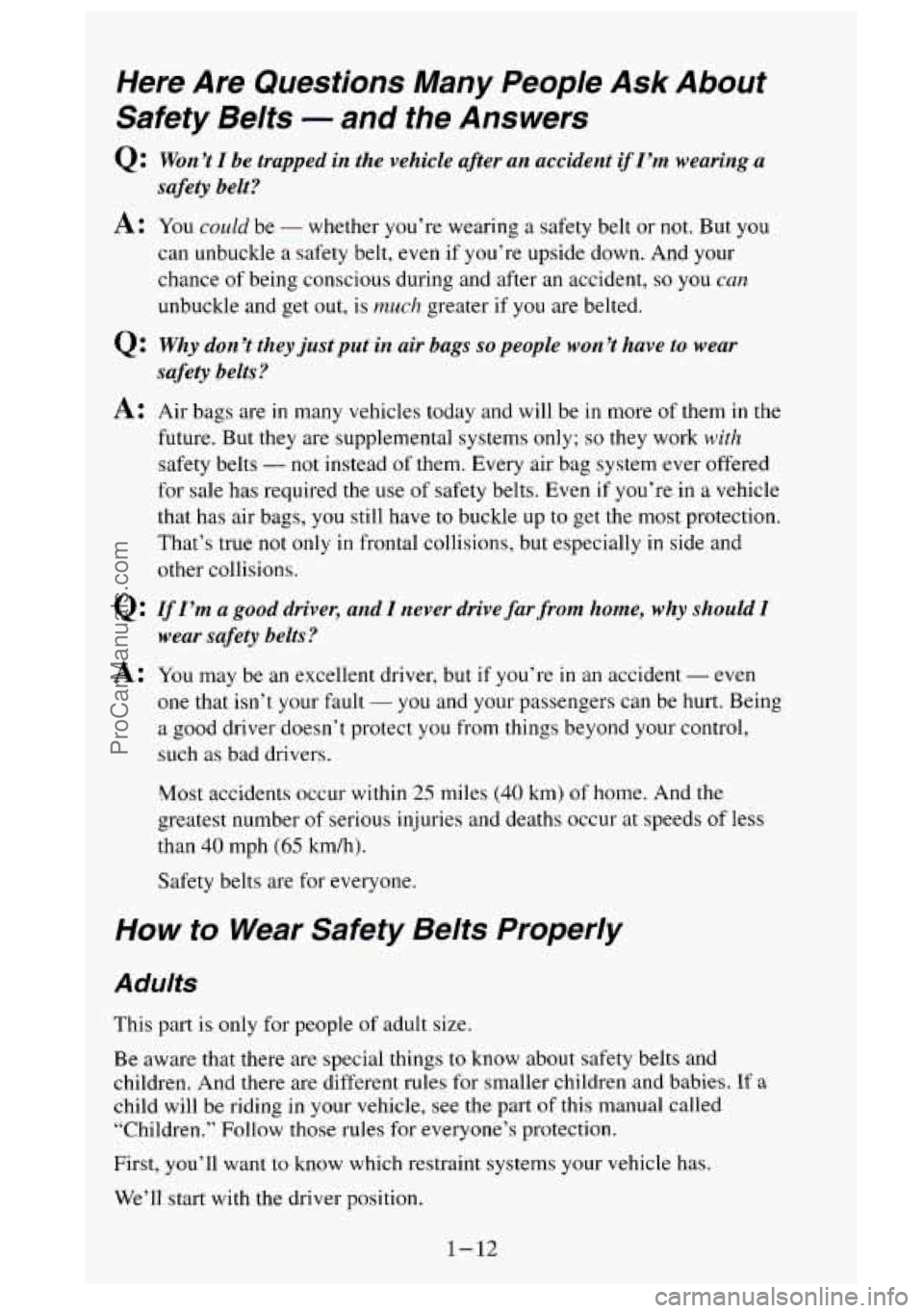
Here Are Questions Many People Ask About
Safety Belts
- and the Answers
Q:
A:
Q:
A:
Q:
A:
Won ’t I be trapped in the vehicle after an accident if I’m wearing a
safety belt?
You could be - whether you’re wearing a safety belt or not. But you
can unbuckle
a safety belt, even if you’re upside down. And your
chance of being conscious during and after an accident,
so you can
unbuckle and get out, is much greater if you are belted.
Why don’t they just put in air bags so people won’t have to wear
safety belts?
Air bags are in many vehicles today and will be in more of them in the
future. But they are supplemental systems only;
so they work with
safety belts - not instead of them. Every air bag system ever offered
for sale has required the use of safety belts. Even
if you’re in a vehicle
that has air bags, you still have
to buckle up to get the most protection.
That’s true not only in frontal collisions, but especially
in side and
other collisions.
If I’m a good drive4 and I never drive far from home, why should I
wear safety belts?
You may be an excellent driver, but if you’re in an accident - even
one that isn’t your fault
- you and your passengers can be hurt. Being
a good driver doesn’t protect you from things beyond your control,
such
as bad drivers.
Most accidents occur within
25 miles (40 km) of home. And the
greatest number of serious injuries and deaths occur at speeds
of less
than
40 mph (65 km/h).
Safety belts are for everyone.
How to Wear Safety Belts Properly
Adults
This part is only for people of adult size.
Be aware that there are special things to know about safety belts and
children. And there are different rules for smaller children and
babies. If a
child will be riding in your vehicle, see the part of this manual called
“Children.” Follow those rules for everyone’s protection.
First, you’ll want to know which restraint systems your vehicle has.
We’ll start with the driver position.
1-12
ProCarManuals.com
Page 37 of 488
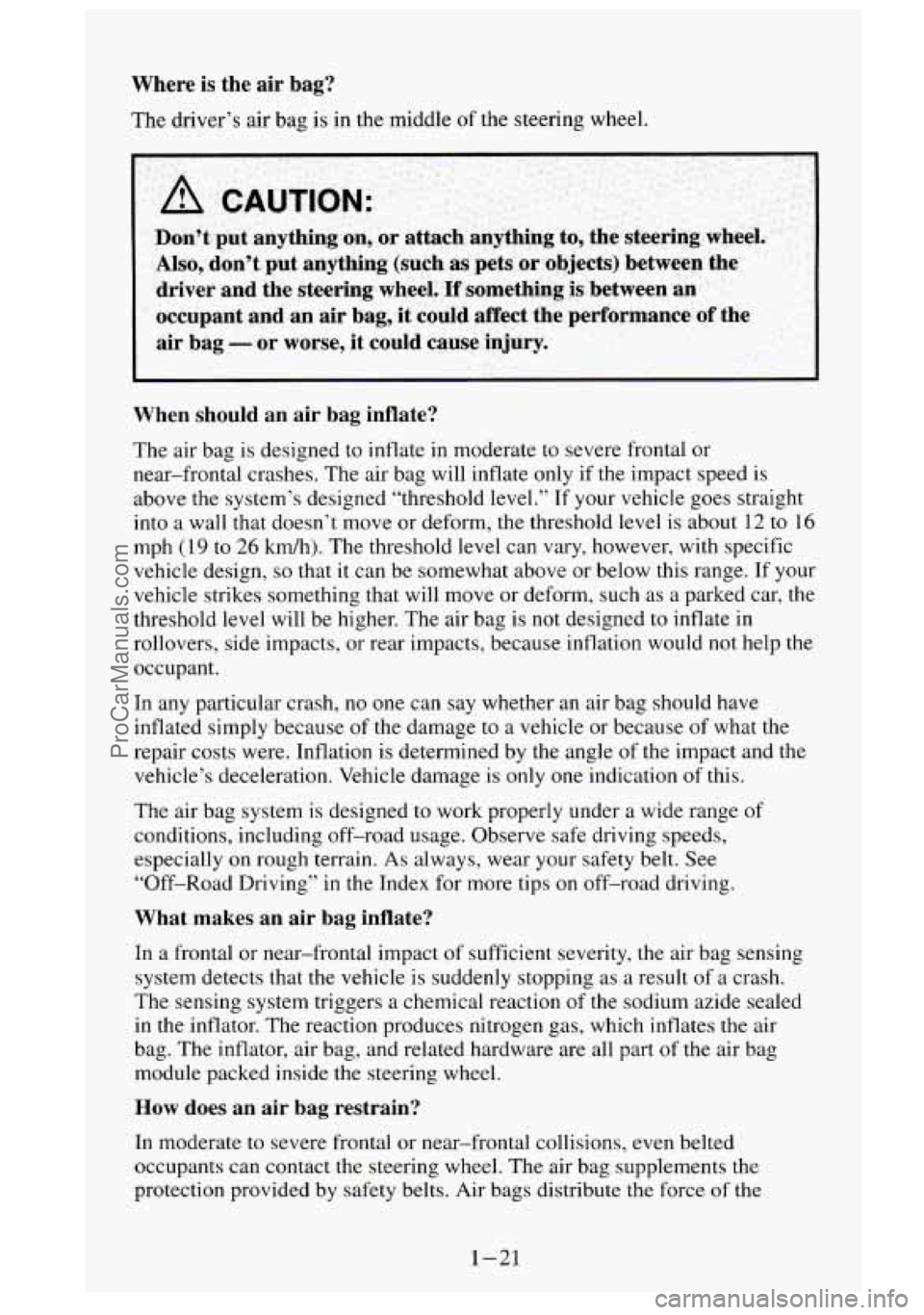
Where is the air bag?
The driver’s air bag is in the middle of the steering wheel.
Don’t put anything on, or attach anything to, the steering \
wheel.
Also, don’t put anything (such as pets or objects) between the
driver and the steering wheel.
If something is between an
occupant and an air bag, it could affect the performance
of the
air bag
- or worse, it could cause injury.
When should an air bag inflate?
The air bag is designed to inflate in moderate to severe frontal or
near-frontal crashes. The air bag will inflate only
if the impact speed is
above the system’s designed “threshold level.” If your vehicle goes straight
into
a wall that doesn’t move or deform, the threshold level is about 12 to 16
mph (19 to 26 kdh). The threshold level can vary, however, with specific
vehicle design,
so that it can be somewhat above or below this range. If your
vehicle strikes something that will move or deform, such
as a parked car, the
threshold level will be higher. The air bag is not designed
to inflate in
rollovers, side impacts, or rear impacts, because inflation would not help the
occupant.
In any particular crash,
no one can say whether an air bag should have
inflated simply because of the damage to
a vehicle or because of what the
repair costs were. Inflation is determined by the angle of the impact and
the
vehicle’s deceleration. Vehicle damage is only one indication of this.
The air bag system
is designed to work properly under a wide range of
conditions, including off-road usage. Observe safe driving speeds,
especially
on rough terrain. As always, wear your safety belt. See
“Off-Road Driving” in the Index for more tips
on off-road driving.
What makes an air bag inflate?
In a frontal or near-frontal impact of sufficient severity, the air bag sensing
system detects that the vehicle is suddenly stopping
as a result of a crash.
The sensing system triggers a chemical reaction of the sodium azide sealed
in the inflator. The reaction produces nitrogen gas, which inflates the air
bag. The inflator, air bag, and related hardware are all part of
the air bag
module packed inside the steering wheel.
How does an air bag restrain?
rn moderate to severe frontal or near-frontal collisions, even belted
occupants can contact the steering wheel. The air bag supplements the
protection provided by safety belts. Air bags distribute the force
of the
1-21
ProCarManuals.com
Page 67 of 488
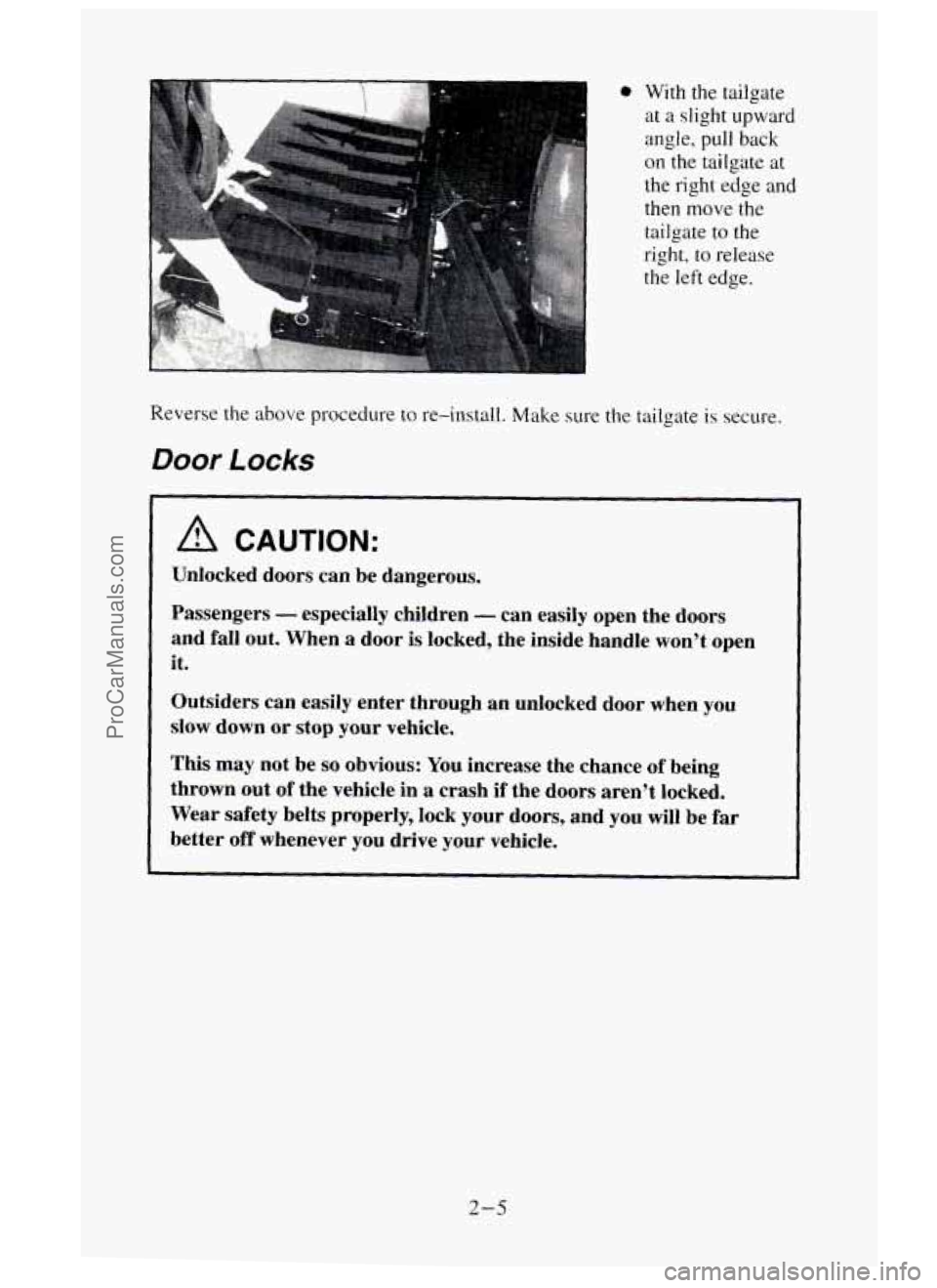
0 With the tailgate
at a slight upward
angle,
pull back
on the tailgate at
the right edge and
then move the
tailgate to the
right,
to release
the left edge.
Reverse
the above procedure to re-install. Make sure the tailgate is secure.
Door Locks
A CAUTION:
Unlocked doors can be dangerous.
Passengers
- especially children - can easily open the doors
and fall out. When a door is locked, the inside handle won’t open
it.
Outsiders can easily enter through an unlocked door when you
slow down or stop your vehicle.
This may not be
so obvious: You increase the chance of being
thrown out
of the vehicle in a crash if the doors aren’t locked.
Wear safety belts properly, lock your doors, and
you will be far
better
off whenever you drive your vehicle.
2-5
ProCarManuals.com
Page 70 of 488
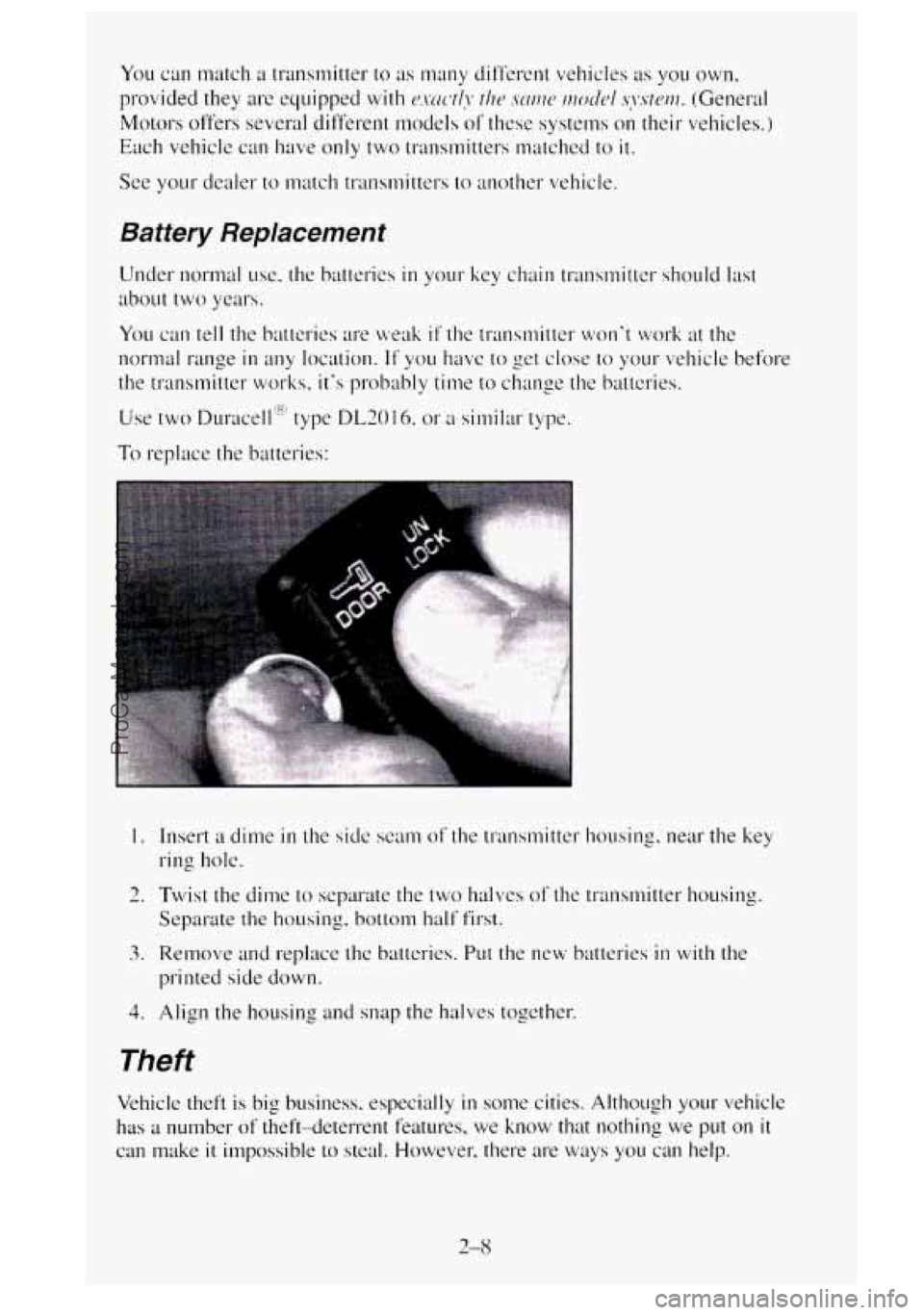
You can match a transmitter to as many difl:rent vehicles as you own.
provided they are equipped with tJ.wctlJ* the sm1c rrlotlol y*sttw. (General
Motors offers several different rnodels 01' these systems on their vehicles.)
Each vehicle can have only two transmitters matched
to it.
See your dealer to match transmitters to another vehicle.
Bafiery Replacement
You can tell the batteries are weak if the transmitter won't work at the
normul range in any location. If you have to get close to your vehicle before
the transmitter works, it's probably time to change the battcries.
Use
two DLKKXII@ type DL20 16. or a similar type.
To replace the batteries:
3 -.
3.
4.
Insert a dime in the sidc seam of the transmitter housing near the key
rins hole.
Twist the dime
to separate the two halves of the transmitter housing.
Separate
the housing, bottom half first.
Remove
and replace the batteries. Put the new batteries in with the
printed side down.
Align the housing and snap the halves together.
Theft
Vehicle theft is big business. especially in some cities. Although your vehicle
has a number of theft-deterrent features. we know that nothing we put on it
can make it impossible to steal. However, there are ways you can help.
2-8
ProCarManuals.com
Page 112 of 488
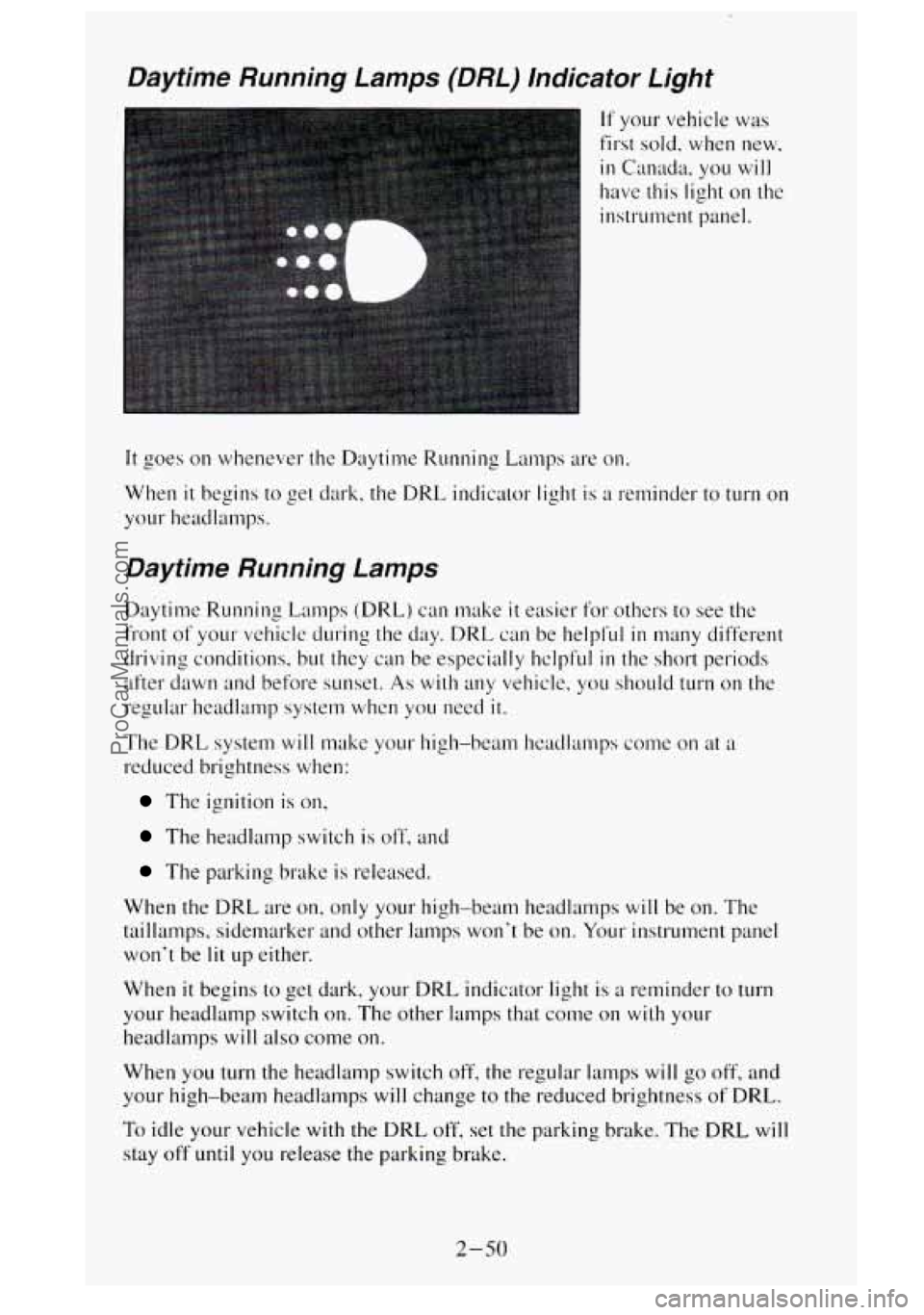
Daytime nunning Lamps (DRL) Indicator Light
If your vehicle was
first sold. when new,
in Canada, you will
have this light on the
instrument panel.
It goes on whenever the Daytime Running Lamps are on.
When
it begins to get dark, the DRL indicator light is a reminder to turn on
your headlanlps.
Daytime Running Lamps
Daytime Running Lamps (DRL) can make it easier for others to see the
front of your vehicle during the day. DRL can be helpfL11
in many different
driving conditions. but they
can be especially hclpful in the short periods
after dawn and before sunset.
As with any vehicle, you should turn on the
regular headlamp system when
you need it.
The DRL system will make your high-beam headlamps come on at a
reduced brightness when:
The ignition is on,
The headlamp switch is off, and
The parking brake is released.
When the
DRL are on, only your high-beam headlamps will be on. The
taillamps, sidemarker and other lamps won‘t be on. Your instrument panel
won’t be
lit up either.
When
it begins to get dark, your DRL indicator light is a reminder to turn
your headlamp switch on. The other lamps that come on with your
headlamps
will also come on.
When you
turn the headlamp switch off, the regular lamps will go off, and
your high-beam headlamps will change
to the reduced brightness of DRL.
To idle your vehicle with the DRL off, set the parking brake. The DRL will
stay off until you release the parking brake.
2-50
ProCarManuals.com
Page 154 of 488
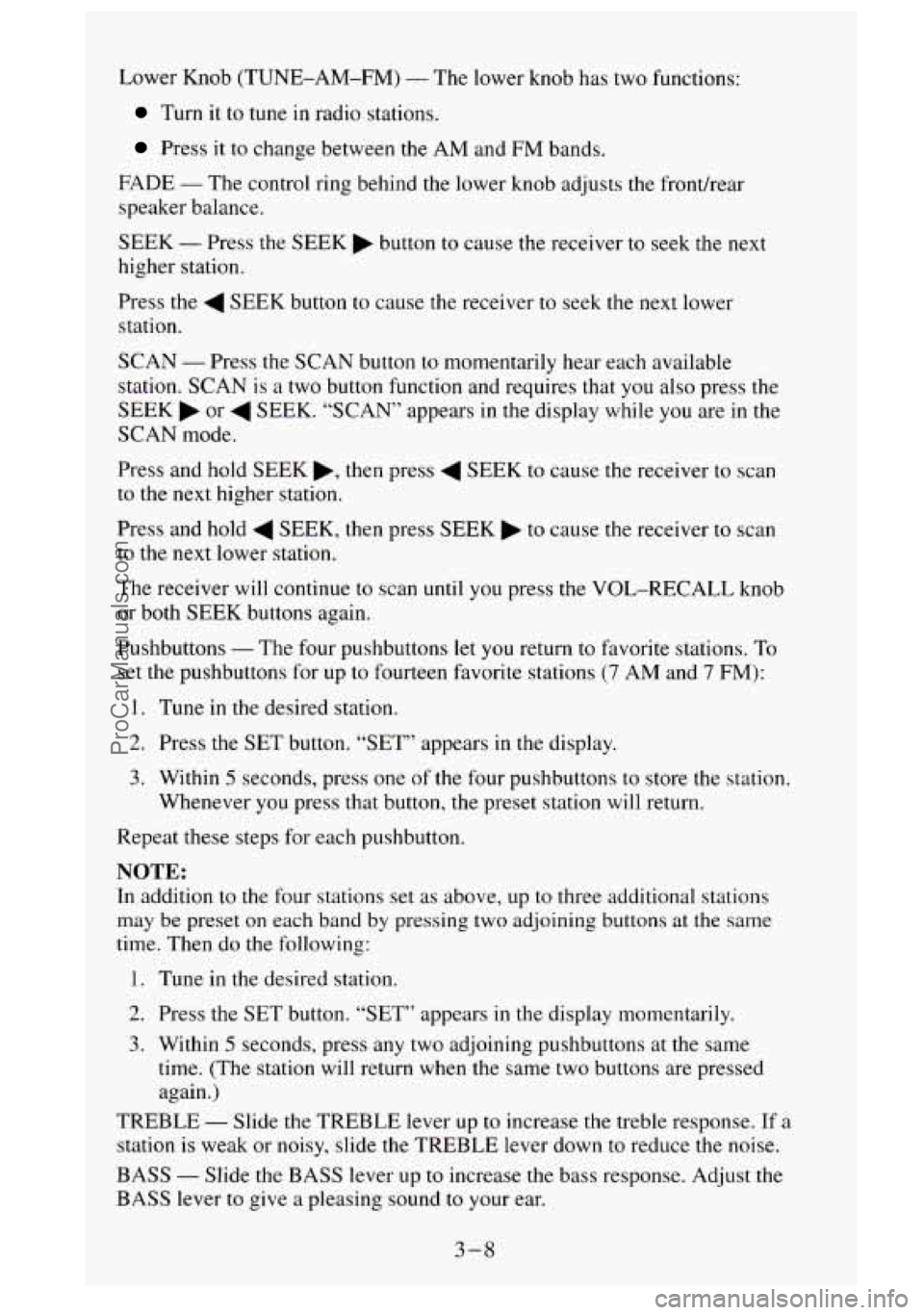
Lower Knob (TUNE-AM-FM) - The lower knob has two functions:
Turn it to tune in radio stations.
Press it to change between the AM and FM bands.
FADE
- The control ring behind the lower knob adjusts the fronthear
speaker balance.
SEEK
- Press the SEEK b button to cause the receiver to seek the next
higher station.
Press the
4 SEEK button to cause the receiver to seek the next lower
station.
SCAN
- Press the SCAN button to momentarily hear each available
station. SCAN is a two button function and requires that you also press the
SEEK
b or 4 SEEK. “SCAN” appears in the display while you are in the
SCAN mode.
Press and hold SEEK
b, then press 4 SEEK to cause the receiver to scan
to the next higher station.
Press and hold
4 SEEK, then press SEEK to cause the receiver to scan
to
the next lower station.
The receiver will continue to scan until
you press the VOL-RECALL knob
or both SEEK buttons again.
Pushbuttons
- The four pushbuttons let you return to favorite stations. To
set the pushbuttons for up to fourteen favorite stations (7 AM and 7 FM):
I. Tune in the desired station.
2. Press the SET button. “SET” appears in the display.
3. Within 5 seconds, press one of the four pushbuttons to store the station.
Whenever you press that button, the preset station will return.
Repeat these steps for each pushbutton.
NOTE:
In addition to the four stations set as above, up to three additional stations
may be preset on each band by pressing two adjoining buttons at the same
time. Then do the following:
1. Tune
in the desired station.
2. Press the SET button. “SET” appears in the display momentarily.
3. Within 5 seconds, press any two adjoining pushbuttons at the same
time. (The station will return when the same two buttons are pressed
again.)
TREBLE
- Slide the TREBLE lever up to increase the treble response. If a
station is weak or noisy, slide the TREBLE lever down to reduce
the noise.
BASS
- Slide the BASS lever up to increase the bass response. Adjust the
BASS lever to give a pleasing sound to your ear.
3-8
ProCarManuals.com
Page 156 of 488
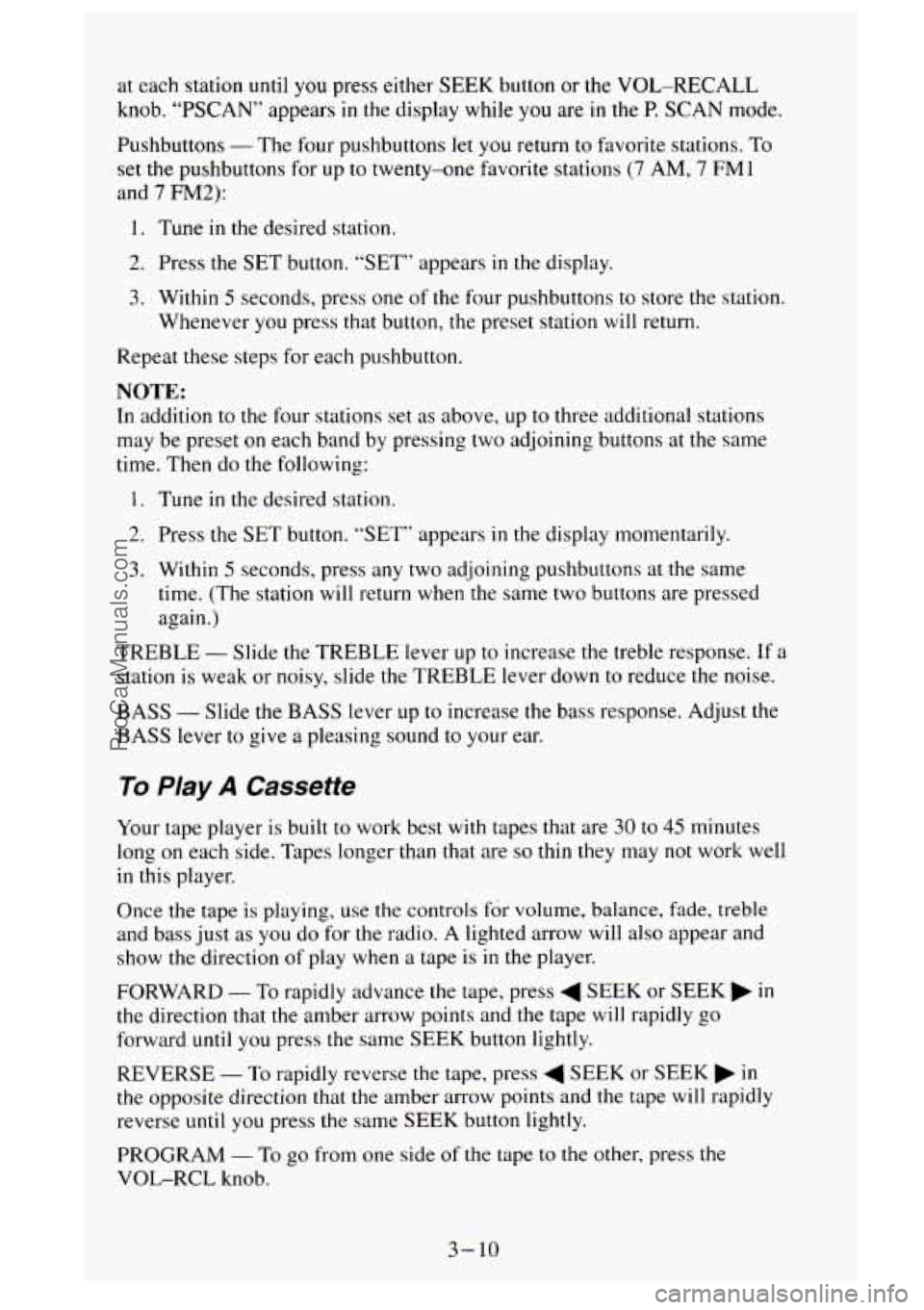
at each station until you press either SEEK button or the VOL-RECALL
knob.
“PSCAN” appears in the display while you are in the P. SCAN mode.
Pushbuttons
- The four pushbuttons let you return to favorite stations. To
set the pushbuttons for up to twenty-one favorite stations (7 AM, 7 FM1
and 7 FM2):
1. Tune in the desired station.
2. Press the SET button. “SET” appears in the display.
3. Within 5 seconds, press one of the four pushbuttons to store the station.
Whenever you press that button, the preset station
will return.
Repeat these steps for each pushbutton.
NOTE:
In addition to the four stations set as above, up to three additional stations
may be preset on each band by pressing two adjoining buttons at the same
time. Then do the following:
1. Tune in the desired station.
2. Press the SET button. “SET” appears in the display momentarily.
3. Within 5 seconds, press any two adjoining pushbuttons at the same
time. (The station will return when the same two buttons are pressed
again.)
TREBLE
- Slide the TREBLE lever up to increase the treble response. If a
station is weak or noisy, slide the TREBLE lever down to reduce the noise.
BASS - Slide the BASS lever up to increase the bass response. Adjust the
BASS lever to give
a pleasing sound to your ear.
To Play A Cassette
Your tape player is built to work best with tapes that are 30 to 45 minutes
long on each side. Tapes longer than that are
so thin they may not work well
in this player.
Once the tape is playing, use the controls for volume, balance, fade, treble
and bass just as you do
for the radio. A lighted arrow will also appear and
show the direction
of play when a tape is in the player.
FORWARD
- To rapidly advance the tape, press 4 SEEK or SEEK in
the direction that the amber arrow points and the tape will rapidly go
forward
until you press the same SEEK button lightly.
REVERSE
- To rapidly reverse the tape, press 4 SEEK or SEEK in
the opposite direction that the amber arrow points and the tape will rapidly
reverse until you press the same SEEK button lightly.
PROGRAM
- To go from one side of the tape to the other, press the
VOL-RCL knob.
3- 10
ProCarManuals.com
Page 159 of 488
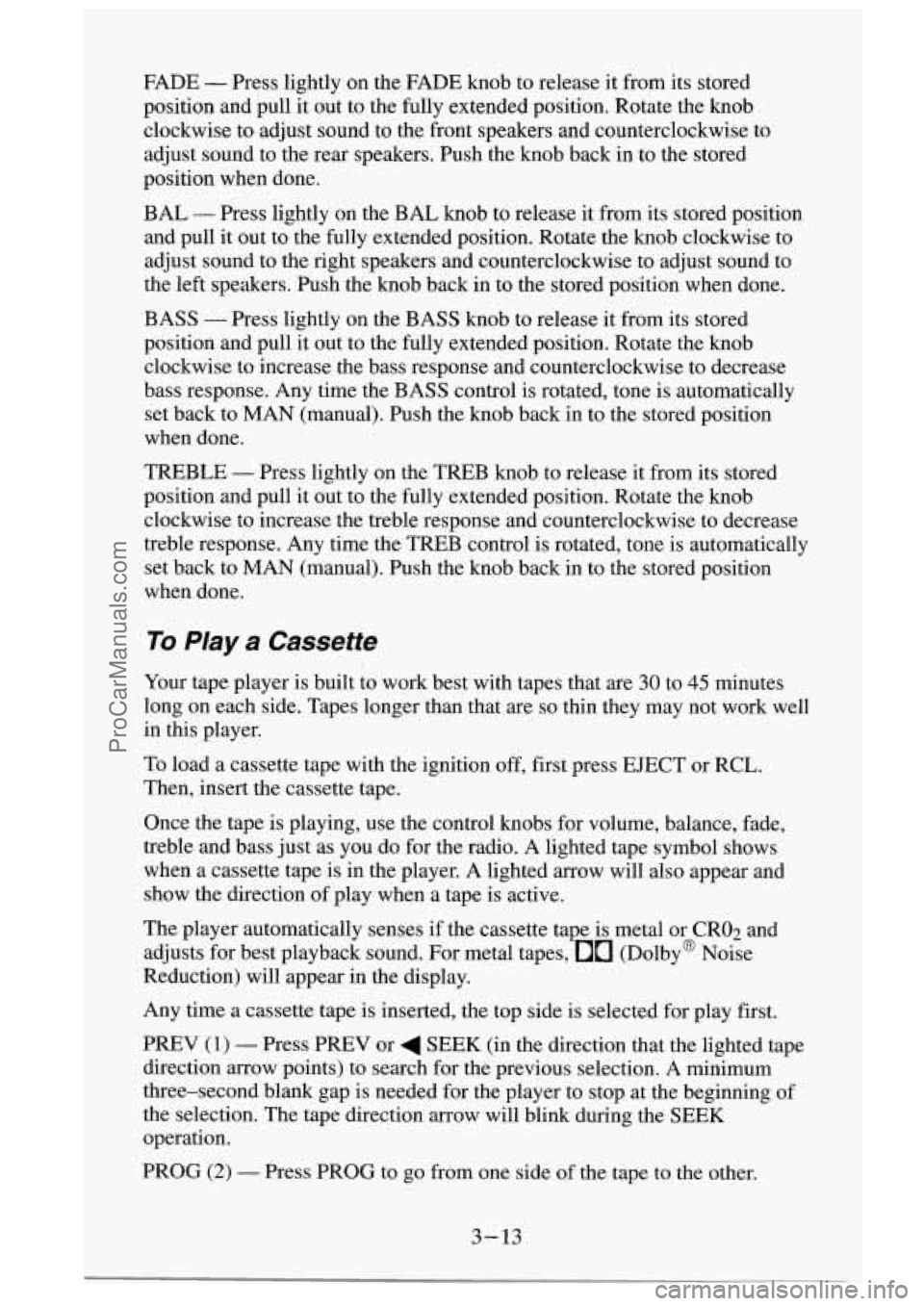
FADE - Press lightly on the FADE knob to release it from its stored
position and pull it out to the fully extended position. Rotate the knob
clockwise to adjust sound to the front speakers and counterclockwise to
adjust sound to the rear speakers. Push the knob back in to the stored
position when done.
BAL
- Press lightly on the BAL knob to release it from its stored position
and pull it out to the fully extended position. Rotate the kn\
ob clockwise to
adjust sound to the right speakers and counterclockwise to adju\
st sound to
the left speakers. Push the knob back in to the stored position when done.
BASS
- Press lightly on the BASS knob to release it from its stored
position and pull it out to the fully extended position. Rotate the knob
clockwise to increase the bass response and counterclockwise to decrease
bass response. Any time the BASS control is rotated, tone
is automatically
set back to MAN (manual). Push the knob back in to the stored position
when done.
TREBLE
- Press lightly on the TREB knob to release it from its stored
position and pull it out to the fully extended position. Rotate the knob
clockwise to increase the treble response and counterclockwise to decrease
treble response. Any time the TREB control is rotated, tone is automatically
set back to MAN (manual). Push the knob back in to the stored position
when done.
To Play a Cassette
To load a cassette tape with the ignition off, first press EJECT or RCL.
Then, insert the cassette tape.
Once the tape is playing, use the control knobs for volume, b\
alance, fade,
treble and bass just as you do for the radio. A lighted tape symbol shows
when a cassette tape is in the player. A lighted arrow will also appear and
show the direction of play when a tape is active.
The player automatically senses if the cassette tape is metal or CRO2 and
adjusts for best playback sound. For metal tapes,
00 (Dolby@ Noise
Reduction) will appear in the display.
Any time a cassette tape
is inserted, the top side is selected for play fiist.
PREV
(1) - Press PREV or 4 SEEK (in the direction that the lighted tape
direction arrow points) to search for the previous selection. A minimum
three-second blank gap is needed for the player to stop at the beginning of
the selection. The tape direction arrow will blink during the SEEK
operation.
PROG
(2) - Press PROG to go from one side of the tape to the other.
3-13
ProCarManuals.com